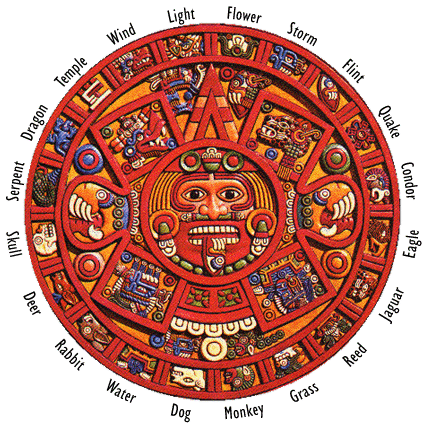
by John P. Pratt
8 Dec 2014, 7 Flint (SR), 1 Elul (UH2), JD 2,457,000
©2014 by John P. Pratt. All rights Reserved.
| 1. Sacred Round |
| 2. U. Hebrew Calendar |
| 3. Life Cycle |
| 3.1 Light Dawns |
| 3.2 Spirit Enters |
| 3.3 Birth |
| 3.4 Evil Appears |
| 3.5 Rebirth |
| 3.6 Death |
| 3.7 Paradise |
| 4. Conclusion |
| Notes |
This article announces that the recently discovered Uniform Hebrew (UH) Calendar works with the Native American Sacred Round (SR) to testify of seven dates of the coming forth of the Book of Mormon. The UH Calendar has been described in a recent article[1], with resultant sacred events occurring on its holy days summarized in another article.[2]
 |
This article presents evidence that the coming forth of the Native American sacred book called the Book of Mormon, was timed using the double witness of the Uniform Hebrew Calendar and the Sacred Round. Together they provide some of the most compelling scientific evidence for the validity of the traditional story of the book coming forth.
Let us look first at the Sacred Round, then at the Uniform Hebrew Calendar, and then at their combined witness of the life cycle of the golden plates from which the Book of Mormon was translated.
The Sacred Round is somewhat complicated, but if the reader will be patient in following this explanation, the resultant witness of the Book of Mormon will be worth the trouble to understand it. The Sacred Round consists of two separate cycles. One is called the veintena, which is Spanish for a set of twenty items. It consists of twenty days which are represented by figures ("glyphs"). They count days consecutively, like the days of our seven-day week, except there are twenty of them.
 |
The other cycle of the Sacred Round is the trecena, which is Spanish for a set of thirteen items. It consists of thirteen days, numbered from 1 to 13, repeating indefinitely. The Sacred Round consists of both the 13-day trecena and the 20-day veintena each advancing one notch daily together. The first day is 1 Light, followed by 2 Wind, etc. It takes 260 days for the two cycles to begin to repeat (on 1 Light). Figure 3 illustrates how the two cycles work together.
The important feature of the veintena needed to be understood for this article is that the twenty figures represent steps of life. Of the twenty, only the first seven are apparently used in the life cycle of the golden plates, from which the Book of Mormon was translated. Some version of these figures were used all over the Americas by many different tribes. The English names which have been chosen to represent them have been chosen from what appear to be the most representative examples.
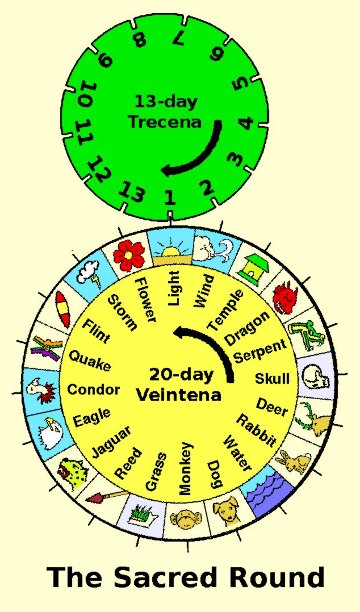 |
Each trecena is named for the glyph preceding its first day. On many of the sacred calendars, there is a day "zero" before the day "1" which acts both as the last day of the last period and the beginning day of the next. The trecena has no "0" so the "13" acts as the zero, much as does the "12" on our clocks. That is, it is 12 o'clock that is the beginning point of a clock face. The trecena named "Light" begins on the day 13 Light, and the "Wind" trecena begins on 13 Wind. Elsewhere on my website the entire 260-day Sacred Round is shown laid out in this manner.[3]
The life cycle described in this paper refers to events in the "life" of the golden plates. The seven steps of announcement, discovery, unearthing, attempted thievery, translation, reburial, and being preached as the Book of Mormon correspond to the first seven glyphs of the veintena.
It is here proposed that the announcement or beginning point of the history of the Book of Mormon occurred during a Light trecena, that is, during the thirteen day period beginning with a day 13 Light. Similarly, the Spirit of God which entered Joseph Smith to induce him to again pray, which led immediately to their discovery, came during a Wind trecena. The day when the golden plates were "born" by being taken out of the ground occurred during a Temple trecena, and so on.
Note that the Light trecena is not followed immediately by the Wind trecena. Because it is only thirteen days long, the trecena immediately following Light is Jaguar. That is because Jaguar is the thirteenth glyph after Light (see Figure 2). The Wind trecena does not come until 221 days (over seven months) after the Light trecena. That means that the very nearest that any of the seven steps in the golden plates' life cycle can be to each other is to be in trecenas separated by 221 days. If the events are father apart, then one must wait for 260 days more for another entire Sacred Round to pass.
All of this mentioned so far is a review of what was published three years ago, so if more detail is desired that article may be consulted.[4] At that time all that could be said was that the event would happen sometime during the indicated trecena. To me it was clear that even with me being allowed to pick the event and which day of the trecena it occurred on, it was still far beyond chance to have those key events all line up in seven 13-day periods over a ten year span. Hence it was published, but it was not overwhelmingly compelling because of the amount of freedom allowing in choosing the events.
Now another witness has sprung forward to testify of these events. Every one of the seven events of the golden plates' life cycle occurred on a day of the indicated trecena which was a holy day on the Uniform Hebrew Calendar. So let us take a look at that calendar.
The Uniform Hebrew Calendar is very similar to the traditional Hebrew Calendar, with the same year lengths and holy days. The major difference is that it is not tied to tracking the seasons of the sun nor lunar month, but slowly rotates around the year. It is used for symbolic alignments on holy days. There is also a secondary version of the UH calendar (UH2), used strictly as a second witness to other dates.
There are several holy days on the UH Calendar, and it is important to understand certain things about some of them to appreciate the discovery being reported in this article.
Passover is usually considered to be the most important spring holy day. It begins when a lamb is chosen and "set apart" from the others. The day for that is called "Consecration" in my articles. Four days later it is sacrificed, roasted, and eaten that evening at the Passover Feast. That feast begins a week long celebration ending on the Last Day of Passover, which is also a holy day.
The Sunday after the Passover Feast is a holy day on which the first sheaf of barley is offered. Each of these holy days symbolized something in the life of Jesus Christ. He was "chosen" at the Triumphal Entry, sacrificed as the Lamb of God at the same time that the Passover Lambs were slain, and he rose at the time of the offering of the sheaf, which represented the firstfruits of the earth. Hence that Hebrew holy day is simply called Easter in my work.
Another holy day on the Hebrew Calendar is called Firstfruits, or the Feast of Weeks. It occurs on the Sunday seven weeks after Easter. This is according the a restored version of the Hebrew Calendar called the Perpetual Hebrew (PH) Calendar. On the traditional calendar both Easter and Firstfruits can occur on other days of the week.
There are also really important holy days in the fall. The first is the Feast of Trumpets. It is a day for important announcement, one of which is to announce the New Year (in autumn). Shortly thereafter is the Day of Atonement. It is the holiest day of the year, being a fast day, when one is to be reconciled with God. Then comes the Feast of Tabernacles five days later. It begins a week-long celebration the ends on another holy day called the Last Day of Tabernacles, or the Great Day of the Feast. One thing represented by the week long feast is the entire life of man, where we come to live in our tabernacle of clay. The first day represents birth and the last day is death.
One other day that is not usually considered to be a holy day, but which is explicitly mentioned in the Bible, is the day on which the rain of the Great Deluge began to fall. Accordingly, it is called Deluge Day in my articles. It is considered a holy day in my work and several prophets were either born or died on that day.
|
The reader hopefully can now understand the discovery being reported in this article. It has two parts. First, each day on which a golden plates' life cycle event occurred was a UH holy day. That means that the ambiguity of knowing which of the thirteen days of the interval is indicated is now resolved. There is one day, or possible more, which is singled out at the correct day. That eliminates the element of the researcher simply being able to choose what day thought to be best.
Moreover, many of the events also occurred on holy days on the traditional Hebrew (and PH) Calendar. The second part of the discovery is that each event matched the symbolism of the exact holy day on which it fell on either the PH or UH Calendar. That is, rather than being on just any holy day, the events fell on the very holy day that corresponds to that step of life. In some cases, the symbolism was even more appropriate than that listed in Table 1. The probability of that happening by random chance for all seven steps is virtually zero. To me this is one of the most compelling witnesses of the Book of Mormon coming forth according to a celestial schedule. Let us now look at each event individually.
 |
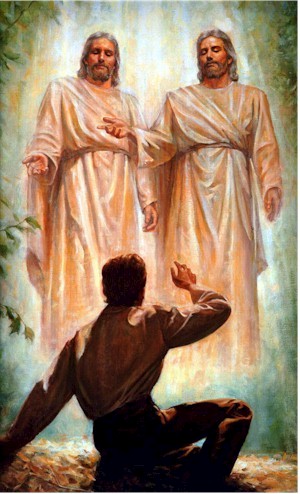 |
In that article it was pointed out that that Friday night began the day Consecration on the Hebrew Calendar, the day when new prophets are chosen. It is also the day that the Passover lamb is "set apart" from the others, later to be sacrificed. Both of those symbolisms were true of Joseph Smith. That was one of the indications that it was the correct day. Now it turns out that both of those days were holy days on the UH2 Calendar. Friday night was the beginning of Passover, when the feast is eaten, and the date of the First Vision was Easter Sunday. So there are two UH holy days which fall in that trecena and two related important events which are here proposed as the first step of the coming forth of the Book of Mormon.
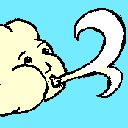 |
Keeping in mind that the second step represents when the Spirit enters to inspire, we are reminded that Joseph said he had been wondering for some time about his worthiness before God. The day Mon 15 Sep 1823 was the day of Atonement on the Hebrew Calendar (as well as PH Calendar) and that day falls into the Wind trecena. As seen in Table 1, Atonement is the precise Hebrew Holy day which corresponds to Wind (Spirit). So that is a bull's-eye. Moreover, on the UH2 Calendar that day was Tabernacles, so that fits the criterion that each of the indicated days be a holy day on the UH Calendar.
Thus it is proposed that on Mon 15 Sep 1823, the Holy Spirit planted the seed in Joseph's heart that he should begin to repent and to pray to again know his standing before God. That was the first day of the Feast of Tabernacles (UH2). At the beginning of the Last Day of Tabernacles (UH2), Sun 21 Sep 1823 after sunset Joseph prayed and the Angel Moroni appeared to him. On the following day, still the Last Day of Tabernacles, he found the golden plates. Thus the week long Feast of Tabernacles fits exactly into a pattern here, from when he began to prepare to pray to when his prayer was answered.
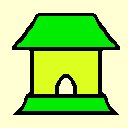 |
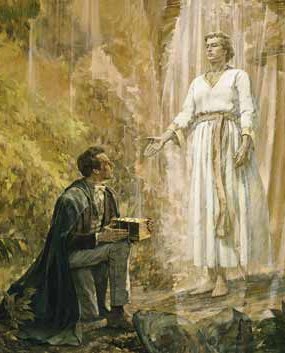 |
Joseph explains in his history that he was not allowed to remove the plates from the earth on this first visit in 1823. Isn't that strange? He goes and finds the plates but is not allowed to get them out. Why? The angel told him that "the time for bringing them forth had not yet arrived" (JS-H 1:53).
Joseph tells us very little about the four subsequent visits on the day 22 Sep each year until 1827 when he was finally allowed to take the plates into his possession. There are accounts of one visit on which he was allowed to remove the plates from the earth and set them down. He then turned away from them to look for other items and when he turned back, the plates were gone. The angel had taken them and then rebuked him for breaking the commandment to keep them in his sight at all times until secured. That sounds a lot like the birth event.
Joseph's mother dates that event to the 1824 visit.[7] If she is correct, then that would not have been the "official" birth event, which is clearly indicated for the following year. But perhaps her memory was faulty about the year and Joseph's first removal of the plates from the ground was indeed in 1825. Either way, it is here proposed that the official coming forth of the plates from the ground occurred on Thu 22 Sep 1825. It is an exact date of one of Joseph's visits, and is witnessed by sacred calendars as their day of birth.
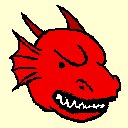 |
A "Dragon" trecena occurred slightly more than two years after the birth of the plates, beginning on Wed 26 Sep 1827. That is very shortly after Joseph was allowed to take the golden plates on Sat 22 Sep 1827. And interestingly enough, Joseph Smith reported that immediately after he was given charge of the plates attempts were made to steal the plates from him. We are not told the exact dates of the attempts, but several different attempts were made to get the plates from him. Some of the attempts involved the use of occult powers to discover where the plates were hidden, and Joseph was just barely warned in time to relocate them. Here the point is that evil forces were employed to steal the plates shortly after he received them.
As we look at that Dragon trecena, sure enough, there was a UH2 holy day in it. And guess which holy day it was! The holy day Deluge Day, the very day on the Hebrew Calendar which symbolizes evil coming, occurred on Mon 1 Oct 1827. That is yet another perfect bull's-eye! And as another witness, the day was also Atonement on the Hebrew Calendar.
Thus it is proposed that the official day on which evil entered the life of the golden plates was Mon 1 Oct 1827, being Deluge Day (UH2). Hopefully the reader is sensing that all of this is far beyond chance occurrences.
 |
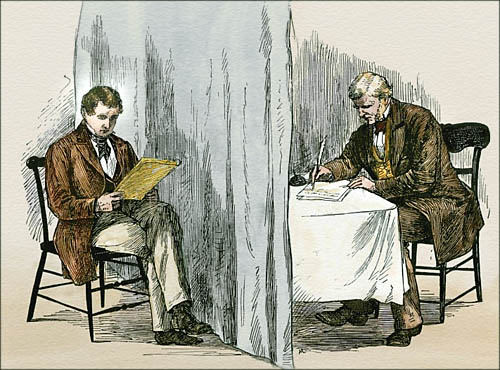 |
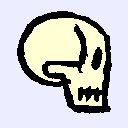 |
The translation of the Book of Mormon was completed by the end of June, 1829. The next Skull (Death) trecena after that occurred on Fri 28 Aug 1829. It has not been clear from my readings exactly what happened to the plates, but it could well be that they were returned to Moroni before that time.
|
If so, then the burial of the plates, perhaps in the cave full of plates which had also been visited by Joseph, would have occurred during the night hours on either Fri 28 Aug 1829 night or before dawn on Sat 29 Aug 1829.
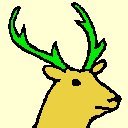 |
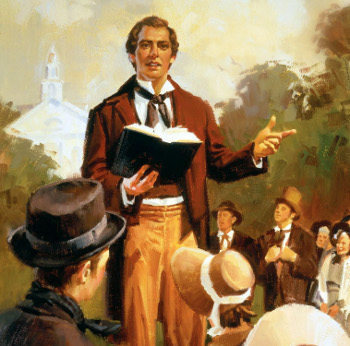 |
Moreover, that very day was also Easter Sunday for the congregation meeting, and also on the Hebrew Calendar. That is also a perfect match because the plates had died and yet come back to life in the spirit. That is, the spirit of the Book of Mormon could now go forth throughout the world, rapidly like a deer, being the spirit of the golden plates.
Table 2 summarizes the precise proposed dates on the Gregorian Calendar for each of the seven steps of the life cycle of the golden plates. Those shown in red are dates known either from historical records or that have been proposed in my work many years ago and hence were not chosen to fit this discovery.
|
Thus it is concluded that the combined testimony of the Sacred Round with the Uniform Hebrew Calendar provides a compelling witness that the Book of Mormon is an authentic Native American sacred book which came forth according to a divinely orchestrated pattern of events which match the cycle of life for the golden plates. The number of perfect hits is so far beyond chance that it leaves no doubt that this information was designed to be discovered as an additional witness in a time when the world has ever-increasing doubts about the even the existence of a Creator. It is also clear that Joseph Smith himself had no idea of the importance of the timing of these events because he often forgot even to note when they happened. His claim, however, that the events happened according to the directions of an angel who had been a Native American during his life now is verified by the events having been scheduled using a Native American calendar.